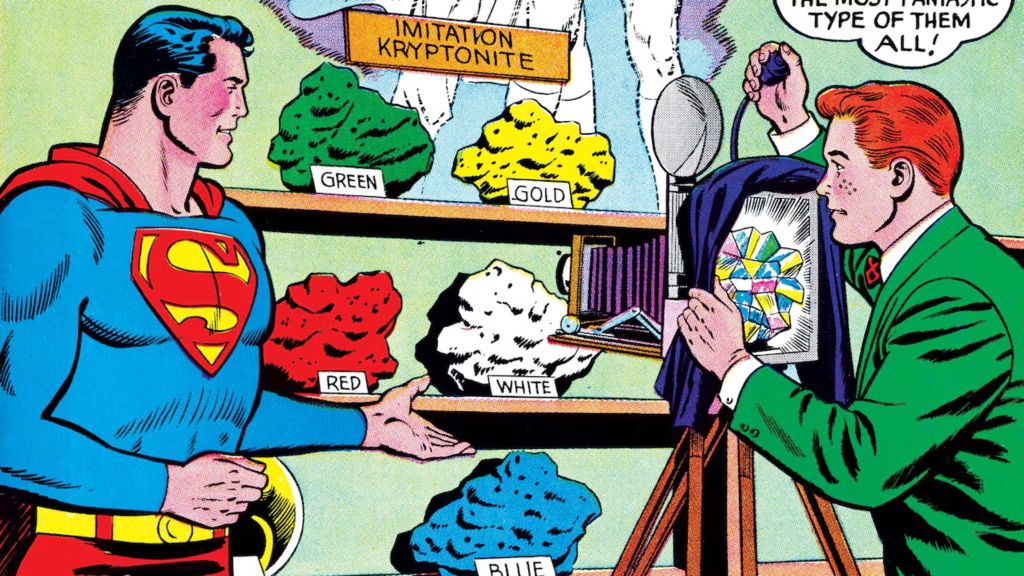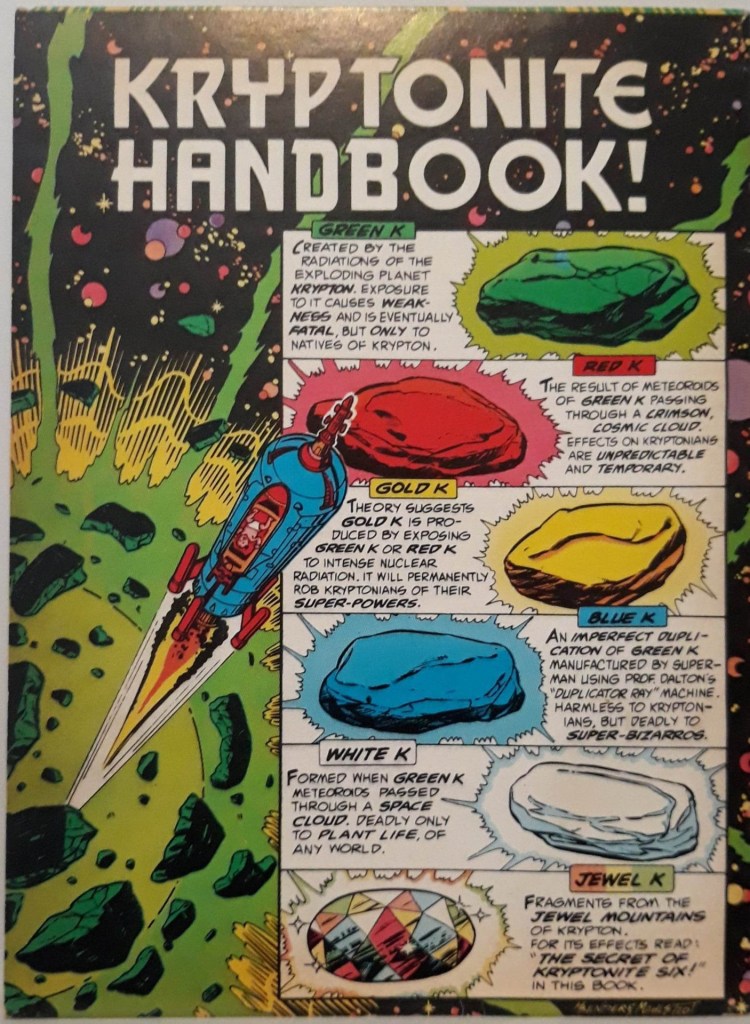By trading Gotham City for Metropolis, Season 5 of Harley Quinn uses its beloved satirical tone to joke about the weirdest aspects of Superman’s history. In the first episode, the show follows Ivy (voiced by Lake Bell) and Harley (voiced by Kaley Cuoco) as they crash into a gala event at Metropolis Museum, where the Man of Steel’s legacy is being honored. As part of the exhibition, there are replicas of colored pieces of Kryptonite, each with a tag that describes their effects on Superman. Of course, we have the classic Green Kryptonite, which drains Superman’s power. However, Harley Quinn digs deep into DC history to joke about weirder artifacts, such as pink and red Kryptonite.
Videos by ComicBook.com
Kryptonite has been integral to Superman’s mythology since it was first introduced in 1943 during the Superman radio serial. The radioactive ore originated from Superman’s home planet, Krypton, making it poetically fitting that fragments of his destroyed world became his greatest weakness. While Green Kryptonite remains the most well-known variant, DC Comics and its derived media have introduced numerous colored versions over the decades, each with unique and sometimes bizarre consequences on the Man of Steel.
[RELATED: Harley Quinn Season 5 Premiere Pays Homage to Superman’s Biggest Cinematic Moment]
Over time, the number of Kryptonite variants grew to include over 30 different types, though many appeared once or twice before being forgotten. Harley Quinn‘s museum exhibition picked six colors to explore the Kryptonite legacy: green, red, gold, blue, white, and pink. Some are obviously in the show for the laughs, while others are ominous nods at future storylines.
Every Harley Quinn Kryptonite, Explained

At the Metropolis Museum, visitors encounter an array of Kryptonite specimens, starting with the infamous Green variant simply labeled “Deadly.” The mineral’s radiation interferes with Kryptonian cellular structures, replacing stored solar energy with toxic emissions that overwhelm their natural healing abilities. Initial exposure triggers intense nerve pain throughout the body, accompanied by nausea and rapid loss of powers. Within minutes, victims experience muscle weakness, difficulty breathing, and vulnerability to physical damage. Prolonged contact leads to radiation poisoning, organ failure, and eventually death. Even brief exposure can weaken Kryptonians for hours afterward as their bodies struggle to purge the radioactive particles and restore solar energy absorption. No wonder this variant remains the most feared substance in Superman’s rogues’ gallery, favored by everyone from street criminals to genius adversaries like Lex Luthor.
The exhibition’s Red Kryptonite display, marked only as causing “Random Effects,” represents one of the most unpredictable artifacts in DC Comics history. First appearing in 1949’s Superman #61, this variant was created when regular Kryptonite passed through a mysterious red cloud in space, fundamentally altering its radiation signature. Red K is particularly frightening because its effects manifest differently with each exposure, lasting anywhere from 24 to 72 hours. In some instances, the mineral split Superman into two beings with opposing personalities; in others, it caused rapid aging or transformed him into various creatures, including a dragon-like Drang. The museum’s vague description acknowledges this chaotic legacy while hinting at the countless possibilities each new exposure might bring.
Created for The Adventures of Superman TV series in 1958, the Gold Kryptonite specimen bears the “No Powers” warning – a deceivingly simple description for a highly complex threat. In Superman’s earliest encounters with this variant, its radiation permanently destroyed a Kryptonian’s ability to process yellow sunlight, effectively rendering them powerless forever. Post-Crisis continuity altered its properties, making the power loss temporary but no less dangerous. In modern interpretations, such as the Injustice timeline, Gold K returned to its permanent effects, with Batman wielding it as the ultimate deterrent against a tyrannical Superman.

The Blue Kryptonite display’s note “Cures Effects of Red” reveals one of the more beneficial applications of Kryptonite radiation. Engineered as a weapon against Bizarro creatures, affecting them as Green K affects Kryptonians, Blue K’s properties have varied significantly since its first appearance in 1960’s Superman #140. In some instances, it acts as a healing agent for non-Kryptonians while suppressing Superman’s superhuman abilities. In Smallville, for example, it rendered Kryptonians powerless but immune to Green K’s radiation. Its most consistent modern use remains an antidote to Red K’s chaotic transformations.
The White Kryptonite section, labeled “Kill Plants,” might appear less threatening than its counterparts, but it’s still quite dangerous. Created when normal Kryptonite underwent cosmic radiation exposure, this variant emits a unique frequency that destroys plant life at the cellular level. While seemingly less relevant to Superman’s rogues’ gallery, its presence in the museum foreshadows trouble for Poison Ivy. A single piece could devastate entire ecosystems, running Ivy’s work in Metropolis. Or, more pertinently, prove lethal to meta-humans whose powers derive from botanical sources.
Finally, the Pink Kryptonite exhibit, noted for its ability to “Swap Gender,” represents a significant reimagining of one of DC’s more controversial artifacts. First appearing in 2003’s Supergirl Vol. 4 #79, Pink K originally altered Superman’s sexual orientation, relying on dated stereotypes for comedic effect. The story portrayed Superman suddenly expressing interest in Jimmy Olsen while making stereotypically gay remarks, a portrayal that was criticized for trivializing LGBTQ+ identities. Harley Quinn‘s reinterpretation as a gender-swapping agent moves away from the original’s insensitive comedy, aligning with the Justice League Action animated series, which similarly changed Pink K’s effects to cause physical transformation rather than orientation changes.
New episodes of Harley Quinn Season 5 premiere on Max every Thursday.








